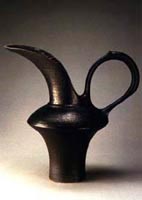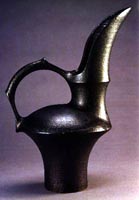 Anne
Hirondelle knew soon after she had started law school that it
was a mistake, but she finished out the first year and then
immediately enrolled in the BFA program at the University of
Washington in Seattle, earning her degree in 1976. Hirondelle
already had a BA in English and an MA in Psychology, but with
the BFA she found her true calling and she has been a full-time
artist ever since. However, that instinct for clear thinking
and logical presentation which initially enticed her to law
school remains in her art. Her work reflects the direct vision
that a clearly-written law brief exhibits.
Anne
Hirondelle knew soon after she had started law school that it
was a mistake, but she finished out the first year and then
immediately enrolled in the BFA program at the University of
Washington in Seattle, earning her degree in 1976. Hirondelle
already had a BA in English and an MA in Psychology, but with
the BFA she found her true calling and she has been a full-time
artist ever since. However, that instinct for clear thinking
and logical presentation which initially enticed her to law
school remains in her art. Her work reflects the direct vision
that a clearly-written law brief exhibits.
When I first encountered Hirondelle’s work 10 years ago, she
was using the diptych format. The pairs of vessels were straight,
formal and hieratic, sitting on a wooden tray which acted as
a plinth for the architectural elements. Each piece was a frozen
still life, best seen from a single perspective. Move one of
the elements and the balanced drama was off kilter. However,
even though the overall effect was cool and disciplined, the
tableaux were not necessarily self-contained. The elements of
the diptych were vessels and the vessels had handles which,
by their nature, invited touch and involvement. They also suggested
function and with function comes human participation.
Over the years, the idea of two equal parts has been modified.
First the elements of the diptych became unequal: sometimes
the two parts consisted of a dominant vessel and subsidiary
base, sometimes vessel and lid. In her most recent exhibition
at The Works Gallery in Philadelphia the various parts have
merged into a single tall unity which Hirondelle calls “aquaria”,
the Latin word for ewer.
“The vessel has always been the core metaphor for my work,”
says the artist. “These particular forms have grown from the
plant forms that surround me in my perennial garden. Women have
been the traditional waterbearers of many cultures,” reflects
the gardener as she remembers the hours she has taken water
to cherished blooms. In ancient times it was the women who fetched
water for the family. Rebecca at the well in the Old Testament
is only one of many examples.
 Hirondelle
lives in Port Townsend, Washington, a beach community of rocks,
not sand, that is close enough to Seattle to share the city’s
cultural advantages, yet far enough not to be a bedroom community.
It is home to one of the country’s most successful publishers
of poetry, Copper Canyon Press, whose founder is one of Hirondelle’s
closest friends. Both the editors and poets often drop in on
her. This easy companionship with poets is telling in her work.
Poetry is about nuance. It is finding just the right shade of
meaning or specific verb to describe a universal feeling. If
the word has too many syllables for the music of the line, it
is jettisoned and a new word must be found. This constant refinement
is also a hallmark in Hirondelle’s work.
Hirondelle
lives in Port Townsend, Washington, a beach community of rocks,
not sand, that is close enough to Seattle to share the city’s
cultural advantages, yet far enough not to be a bedroom community.
It is home to one of the country’s most successful publishers
of poetry, Copper Canyon Press, whose founder is one of Hirondelle’s
closest friends. Both the editors and poets often drop in on
her. This easy companionship with poets is telling in her work.
Poetry is about nuance. It is finding just the right shade of
meaning or specific verb to describe a universal feeling. If
the word has too many syllables for the music of the line, it
is jettisoned and a new word must be found. This constant refinement
is also a hallmark in Hirondelle’s work.
Her current body of work is remarkably consistent. Each piece
is dipped in the same soda ash glaze and fired to the same temperature.
They look metallic with an occasional freckle of crust on their
skin. The forms – the aquaria – are also consistent, all springing
from the same columnar base that flares into a full skirt. However,
the subtleties reveal themselves with a closer reading. Sometimes
the neck is only a choker wide before the spout takes over.
Sometimes it stretches as long as the throats of the African
women who wear copper coils to extend their necks. And the oversized
spouts have individual personalities. One is perpendicular and
resembles an old-fashioned coal scoop. Others are angled into
the same neck-thrusting motion of an egret or a crane. Several
have a slightly inward curling lip such as the large petal of
a calla lily. Even though the pieces are all watergivers, some
of the spouts look as though they would be awkward for
pouring, their strong personalities getting in the way of easy
function.
To balance the exaggerated spouts, the handles either make
a circle or follow the more gradual profile of a flying buttress.
Aesthetically they keep the ewer from tipping forward by being
the weight on the other end of the pulley. They are the counterpoint
to the strong forward motion. Many have thumb rests for
easier gripping. But when put to the test, these aquaria are
too large and massive to use. They are made of thick-walled
stoneware and when filled with water, they would be quite heavy.
Better to enjoy them as three dimensional design rather to take
their function literally. Each aquaria belongs in a place of
honour where it can be given poetic licence to be conceptual
rather than actual water bearers.
Gretchen Adkins is a writer on the arts from
New York, NY. Caption title page: Aquaria #36. 1997. 68 x 32.5
x 29 cm. Photographs courtesy of Garth Clark Gallery, New York.
More Pots of the Week